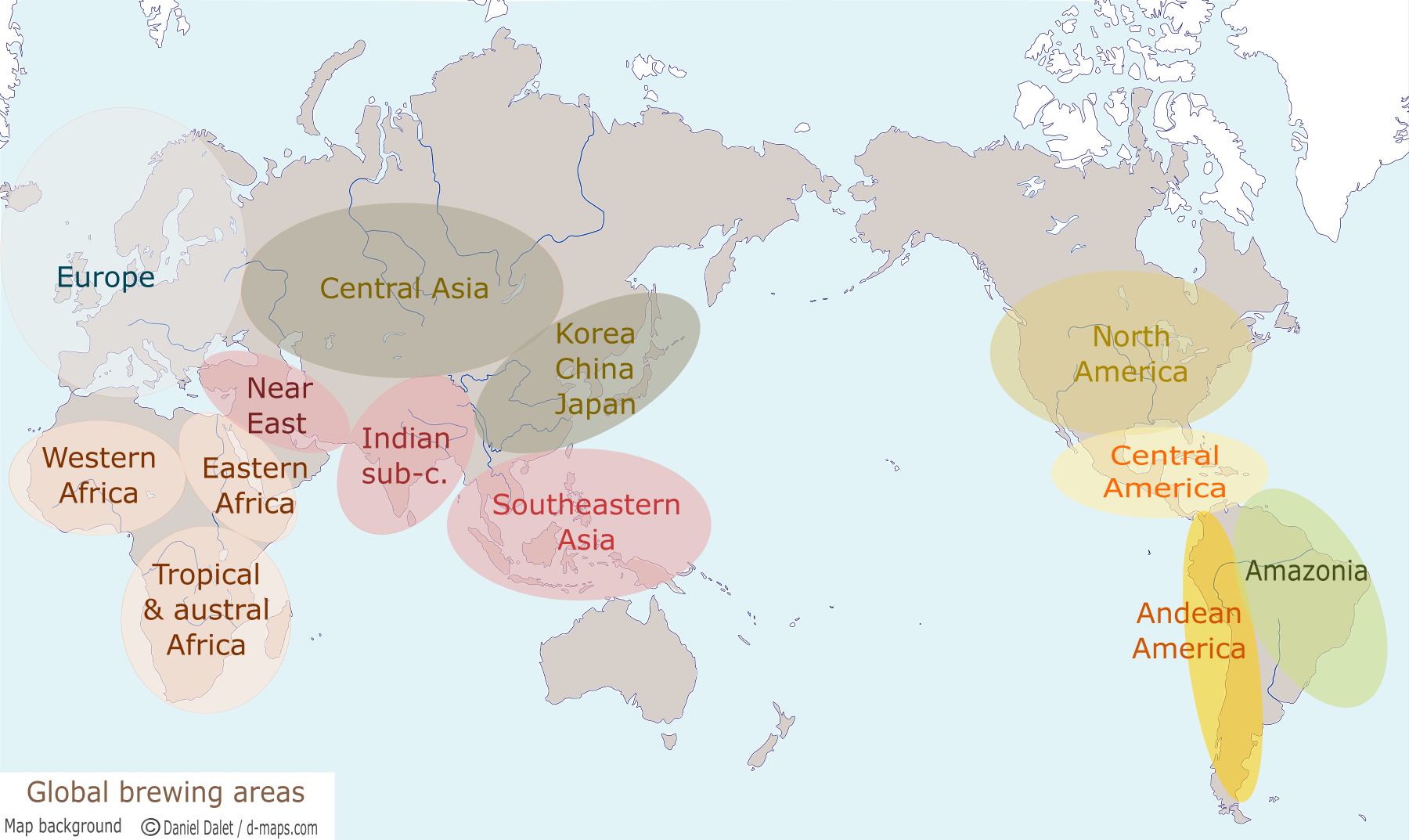Central America and Mexico
- Bruman Henry 2000, Alcohol in Ancient Mexico. University of Utah, Salt Lake City.
- Between 1938 and 1940, Bruman looked for traces of ancient fermented drinks among the Amerindians of Mexico, notably the Huichols. This book published his 1940 thesis "Native drink areas in New Spain". Several reasons make it unavoidable 1) Bruman's ambitious research attempted to reconstruct the geography of fermented drinks before the Spanish conquest 2) the field observations made by Bruman in the 1930s relifted cultural traits as the accelerated "Mexicanization" of Native American cultures has since disappeared. 3) avant-garde in 1938, the combined approaches - local + regional - of the geographer (North Mexico to the Isthmus of Panama) and medium scale of the historian (1492-19th century) - proved their effectiveness to reconstruct the ancient lanscape of the native fermented beverages.
- Coe Sophie D. 1994, America's First Cuisines. University of Texas Press, Austin.
- Dahlin H. Bruce, William J. Litzinger 1986, Old Bottle, New Wine: the Function of Chultums in the Maya Lowlands, American Antiquity51, 721:736.
- The function of the chultums, shoe-shaped cavities dug in the rocks near the Maya dwellings, has always intrigued archaeologists. The authors propose them as a device for preparing and storing fermented foods and drinks. The chultum, a humid, warm and open cavity, would be favorable for the development of microorganisms and therefore the preparation of amylolytic ferments (pancakes, smoked corn balls covered with molds) to brew maize beer.
- Deimel Claus 1980, Les Indiens Tarahumaras au présent et au passé. Traduit de l'allemand. Editions Fédérop.
- Numerous quotations drawn from the accounts of the Jesuit missions that Joseph Neuman and Johannes Ratkay made in the land of the Tarahumaras from 1680. The description of the tesguïnadas, the corn beer festivals is very important.
- Eber Christine 1995, Women & Alcohol in a Highland Maya Town. Water of Hope, Water of Sorrow. University of Texas Press, Austin.
- Farnsworth Paul 2001, Beer Brewing and Consumption in the Maintenance of African Identity by the Enslaved People of the Bahamas, 1783-1834, Culture & Agriculture 23(2), 19:30.
- The slaves of African origin had retained knowledge of the brewing of beer. Indirect evidence from excavations of old 18th century plantations in the Bahamas.
- Fournier Dominique 1991, Les vicissitudes du divin au Mexique. L'évêque, le juge et le pulque. In Le Ferment Divin, ed. D. Fournier et S. D'Onofrio, pp 225-240.
- Fournier Dominique 1996, Le pulque au Mexique, entre préparation culiniare et production artisanale. In Cuisines, Reflets des Sociétés, Marie Claire Bataille-Benguigui & Françoise Cousin, 308:324.
- No direct connection with beer except the fascinating proximity of pulque and tesguïno (corn beer) in the same geographical and historical area, central Mexico.
- Kennedy J. 1963, Tesguino Complex: The Role of Beer in Tarahumara Culture, American Anthropologist 65(3), 620:640.
- Litzinger William Joseph 1983, The Ethnobiology of alcoholic beverage production by the Lacandon, Tarahumara, and other aboriginal mesoamerican peoples. PhD. University of Colorado.
- In-situ studies of the brewing processes for maize or cassava beers, microorganisms and vegetable additives.
- Lupo Alessandro 1991, L'eau bénie. Valeurs symboliques de l'alcool dans la pensée religieuse des Nahua de la Sierra de Puebla. In Le Ferment Divin, ed. D. Fournier et S. D'Onofrio, pp 241-251.
- Mitchell Tim 2004, Intoxicated Identities. Alcohol's Power in Mexican History and Culture. Routledge ed., New-York.
- Pennington Campbell 1969, The Tepehuan of Chihuahua, their material culture. Utah University Press.
- Campbell Pennington is a specialist in Native American cutures from northern Mexico. His 3 monographs are authoritative. The maize beer is the social and central drink of the groups he studied.
- Pennington Campbell 1980, The Pima Bajo of Central Sonora, Mexico. Vol I Material culture. Vol II Vocabulario en la lengua Nevome. Utah Univ. Press.
- Pennington Campbell 1996, The Tarahumar of Mexico, their environnment and material culture (1ère publication 1963).
- Zizumbo-Villarreal Daniel, González-Zozaya Fernando, Olay-Barrientos Angeles, Almendros-López Laura, Flores-Pérez Patricia, Colunga-Garcíamarín Patricia 2009, Distillation in Western Mesoamerica before European Contact, Economic Botany 63(4), 413:426.
Click an area for other regional bibliographies.



